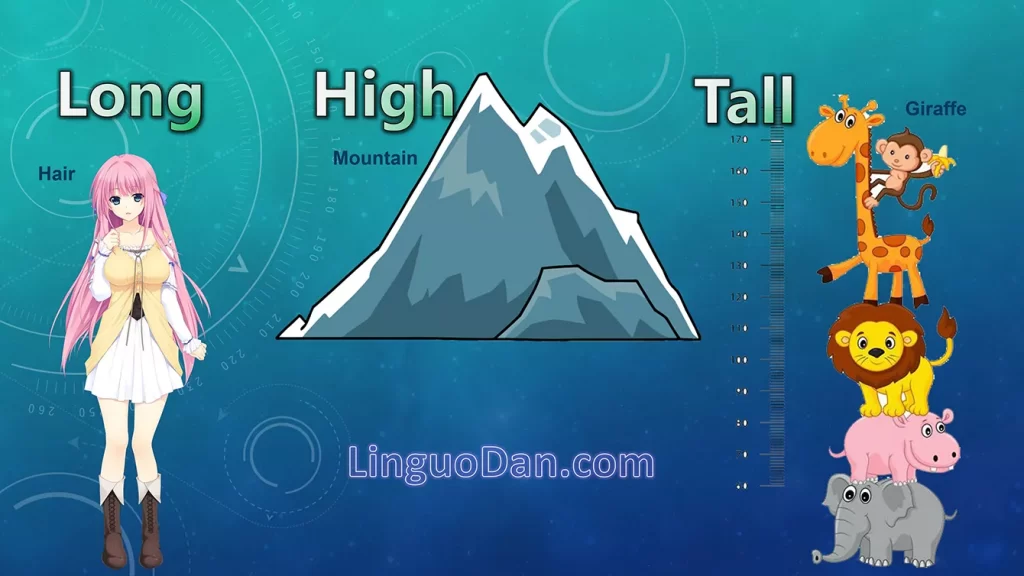Differences between Long, Tall, and High in English

What is the difference between “Long,” “Tall” and “High”?
The English language offers a plethora of words to describe length, height, and distance. Three commonly used adjectives that can cause confusion are “long,” “tall,” and “high.” While they may seem interchangeable, each word has its distinct meaning and usage. In this article, we will explore the differences between “long,” “tall,” and “high,” enabling you to communicate more accurately and confidently in English.
Long
The word “long” primarily denotes horizontal or linear extent. It refers to the measurement of length from one end to the other, emphasizing the duration, physical distance, or extent of an object. For example, you would use “long” to describe a road, a snake, or a river that extends over a considerable distance. Additionally, “long” can also be employed to describe the duration of time, such as “a long wait” or “a long movie.”
Tall
Tall is used specifically to describe vertical height, typically in relation to the human figure or objects with vertical dimensions. It implies a significant distance from the base to the top and is often associated with people, buildings, or natural structures. For instance, you would describe a person as “tall” if they have an above-average height, or a skyscraper as “tall” due to its impressive vertical stature. However, it is worth noting that “tall” is not commonly used for inanimate objects or non-vertical entities.
High
The word “high” primarily relates to vertical elevation or vertical distance from a reference point. It is often used to describe the height of objects or locations above the ground or sea level. For instance, you would use “high” to describe a mountain peak, an airplane flying at a significant altitude, or a kite soaring in the sky. “High” can also be used metaphorically to express a state of intensity, such as “high temperature” or “high energy.”
Usage Examples
Long
- The Great Wall of China is a long structure that stretches for thousands of miles
- The movie was so captivating that it felt like a long journey
- We took a long drive along the coast to enjoy the scenic views
Tall:
- John is a tall basketball player, standing at 6 feet 5 inches
- The tall trees provided shade from the scorching sun
- The Eiffel Tower is one of the tallest landmarks in the world
High:
- The airplane soared high above the clouds
- The mountain peak reached a staggering height of 8,848 meters
- The singer’s performance at the concert was a high point of the evening
Similarities
| Long | Tall | High | |
|---|---|---|---|
| Measurement of length/height | ✔️ | ✔️ | ✔️ |
| Descriptive words | ✔️ | ✔️ | ✔️ |
| Associated with size and dimensions | ✔️ | ✔️ | ✔️ |
| Used to describe objects or people | ✔️ | ✔️ | ✔️ |
Differences
| Long | Tall | High | |
|---|---|---|---|
| Primary orientation | Horizontal | Vertical | Vertical |
| Focuses on | Extent | Height | Elevation |
| Objects it commonly describes | Roads, rivers, durations | People, buildings, trees | Mountains, altitudes, levels |
| Usage for non-vertical objects | ✔️ | ❌ | ❌ |
| Usage for intensity or metaphorical expressions | ❌ | ❌ | ✔️ |
While “long,” “tall,” and “high” are related to measurements and dimensions, they each have specific applications in the English language. “Long” pertains to horizontal or linear extent, “tall” focuses on vertical height, particularly in relation to people or objects, and “high” describes vertical elevation or intensity. Understanding the nuances of these words will enhance your ability to communicate accurately and precisely. Pay attention to the context and the nature of what you are describing, and practice their usage to further develop your English language skills.